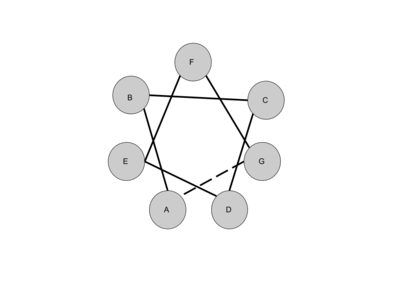User:Jonathon Ferrell/Sandbox 1
From Proteopedia
< User:Jonathon Ferrell(Difference between revisions)
| Line 5: | Line 5: | ||
The design of this protein occurred in two different phases; the initial design of the alpha bundle helix and then the installation of the cysteine hydrolase functional triad into that bundle.<ref name="hydrolase">DOI 10.1038/nchem.2555</ref> | The design of this protein occurred in two different phases; the initial design of the alpha bundle helix and then the installation of the cysteine hydrolase functional triad into that bundle.<ref name="hydrolase">DOI 10.1038/nchem.2555</ref> | ||
====α-Barrel Design==== | ====α-Barrel Design==== | ||
| - | The design of the coiled coiled heptamer occurred previously, in which a computational and geometrical framework was created. This framework was inspired by classical α-helical bundles that use a heptad repeat, generally written as abcdefg, with the a and d positions occupied by hydrophobic amino acids. This gives rise to hydrophobic seams which can give rise to aggregation and coiled coils which are generally further stabilized by charged interactions at the g and e positions. However in an α-barrel each helix acts with an independent hydrophobic seam with its neighbor. The resulting possible interactions from this interface can be broken down into three types of which type II is utilized for the CC-Heptamer in which a, d, e, and g are all hydrophobic. These principles were used to create [http://coiledcoils.chm.bris.ac.uk/app/cc_builder/example_art_hex2/ CCBuilder] (of which their is a newer version [http://coiledcoils.chm.bris.ac.uk/ccbuilder2/builder CCBuilder 2.0], an in silico modeler of α-helical coiled coils and α-barrels. <ref>DOI 10.1126/science.1257452</ref> | + | The design of the coiled coiled heptamer occurred previously, in which a computational and geometrical framework was created. This framework was inspired by classical α-helical bundles that use a heptad repeat, generally written as abcdefg, with the a and d positions occupied by hydrophobic amino acids. This gives rise to hydrophobic seams which can give rise to aggregation and coiled coils which are generally further stabilized by charged interactions at the g and e positions. However in an α-barrel each helix acts with an independent hydrophobic seam with its neighbor. The resulting possible interactions from this interface can be broken down into three types of which type II is utilized for the CC-Heptamer in which a, d, e, and g are all hydrophobic. These principles were used to create [http://coiledcoils.chm.bris.ac.uk/app/cc_builder/example_art_hex2/ CCBuilder] (of which their is a newer version [http://coiledcoils.chm.bris.ac.uk/ccbuilder2/builder CCBuilder 2.0]), an in silico modeler of α-helical coiled coils and α-barrels. <ref>DOI 10.1126/science.1257452</ref> |
[[Image:heptad.png | thumb | right | 400px |'''Visual representation of the heptad repeats''' ]] | [[Image:heptad.png | thumb | right | 400px |'''Visual representation of the heptad repeats''' ]] | ||
====Installation of Cysteine Hydrolase==== | ====Installation of Cysteine Hydrolase==== | ||
Current revision
CC-Heptamer Hydrolase
| |||||||||||
References
- ↑ 1.0 1.1 1.2 Burton AJ, Thomson AR, Dawson WM, Brady RL, Woolfson DN. Installing hydrolytic activity into a completely de novo protein framework. Nat Chem. 2016 Sep;8(9):837-44. doi: 10.1038/nchem.2555. Epub 2016 Jul 4. PMID:27554410 doi:http://dx.doi.org/10.1038/nchem.2555
- ↑ Thomson AR, Wood CW, Burton AJ, Bartlett GJ, Sessions RB, Brady RL, Woolfson DN. Computational design of water-soluble alpha-helical barrels. Science. 2014 Oct 24;346(6208):485-8. doi: 10.1126/science.1257452. PMID:25342807 doi:http://dx.doi.org/10.1126/science.1257452
- ↑ Zaccai NR, Chi B, Thomson AR, Boyle AL, Bartlett GJ, Bruning M, Linden N, Sessions RB, Booth PJ, Brady RL, Woolfson DN. A de novo peptide hexamer with a mutable channel. Nat Chem Biol. 2011 Oct 30. doi: 10.1038/nchembio.692. PMID:22037471 doi:10.1038/nchembio.692
- ↑ Burton AJ, Thomas F, Agnew C, Hudson KL, Halford SE, Brady RL, Woolfson DN. Accessibility, Reactivity, and Selectivity of Side Chains within a Channel of de Novo Peptide Assembly. J Am Chem Soc. 2013 Aug 13. PMID:23924058 doi:10.1021/ja4053027

